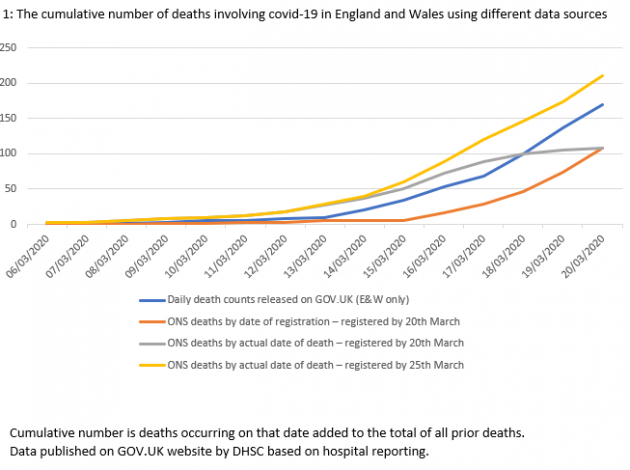Counting deaths involving the coronavirus (COVID-19)

Knowing the exact number of people whose death involved coronavirus (COVID-19) is of great importance, but it’s not a simple question. Sarah Caul introduces the provisional new figures published on 31 March and explains why the different ways of counting used across the government give different answers.
What has ONS published about deaths involving coronavirus (COVID-19)?
From 31 March, our usual weekly publication of the provisional number of deaths registered in England and Wales includes separate counts of deaths involving coronavirus (COVID-19). We have included in the count every death registered in the relevant week for which COVID-19 was mentioned on the death certificate (whether as the underlying cause of death or not).
There were 108 death registrations involving COVID-19 up until 20 March 2020 – 5 in week ending 13 March and 103 in week ending 20 March. But it takes at least five days for most deaths to be certified by a doctor, registered and the data processed, so our figures are always slightly out of date. To understand the trend over time, it is helpful to look at the date of death, as in Figure 1.
The chart shows for each day the number of deaths involving COVID-19 that were registered, the number that actually happened according to our knowledge as of 20 March (the cut-off for the weekly deaths release on 31 March), and the number that actually happened if we include all those we knew about on 25 March. Also shown is the number of deaths per day for England and Wales that have been included in the daily counts published on the GOV.UK website.
Why are the ONS numbers different from the GOV.UK counts?
The Department of Health and Social Care (DHSC) release daily updates on the GOV.UK website, reporting the number of deaths occurring in hospitals in the UK among patients who have tested positive for coronavirus. Although the main figure reported is for the whole UK, breakdowns by area are available. These are the most up-to-date data available on the trend in deaths involving COVID-19, being compiled from reports sent every day by local hospitals.
Figure 1 shows the differences between the ONS and GOV.UK data. For example on one day, 17 March, there were 69 COVID-19 deaths reported on GOV.UK, 29 deaths registered, 89 deaths that occurred based on those registered up to 20 March, and 120 deaths based on those registered up to 25 March.
The chart shows that ONS figures by registration date roughly follow the GOV.UK figures, with a short time-lag. This reflects the time between a death taking place and being officially registered. The GOV.UK figures for each day include deaths that had not yet been registered on that day.
On the other hand, ONS figures by actual date of death (death occurrence) tend to be higher than the GOV.UK figures for the same day. This is because:
- We include all deaths where COVID-19 was mentioned on the death certificate, even if only suspected: the GOV.UK figures are only those deaths where the patient had a positive test result
- We include deaths that happened anywhere in England and Wales, for example some might be in care homes: the GOV.UK figures are only those that happened in hospital.
How much higher the latest ONS occurrence figure is compared to the GOV.UK figure depends on how much time has passed for the deaths to be registered. For the more recent days, not all the deaths reported by hospitals had yet been registered, so the ONS figures are lower. We regularly publish information on the time taken between a death occurring and being registered.
So who is right about the number of deaths?
The issue is not really about right or wrong, but about each source of data having its own strengths and weaknesses.
The figures published on GOV.UK are valuable because they are available very quickly, and give an indication of what is happening day by day. Their definition is also clear, so the limitations of the data can be understood. But they won’t necessarily include all deaths involving COVID-19, such as those not in a hospital.
Numbers produced by ONS are much slower to prepare, because they have to be certified by a doctor, registered and processed. But once ready, they are the most accurate and complete information.
Using the complete death certificate allows us to analyse a lot of information, such as what other health conditions contributed to the death. We will start publishing more detailed breakdowns of the figures as soon as possible.

Sarah Caul, Head of Mortality Analysis at ONS
